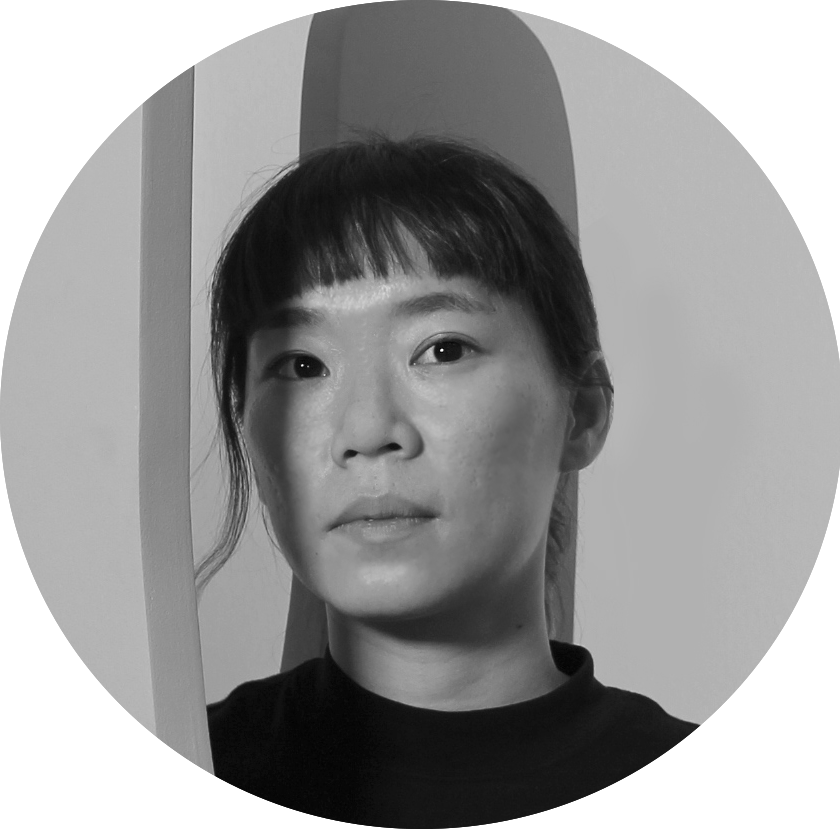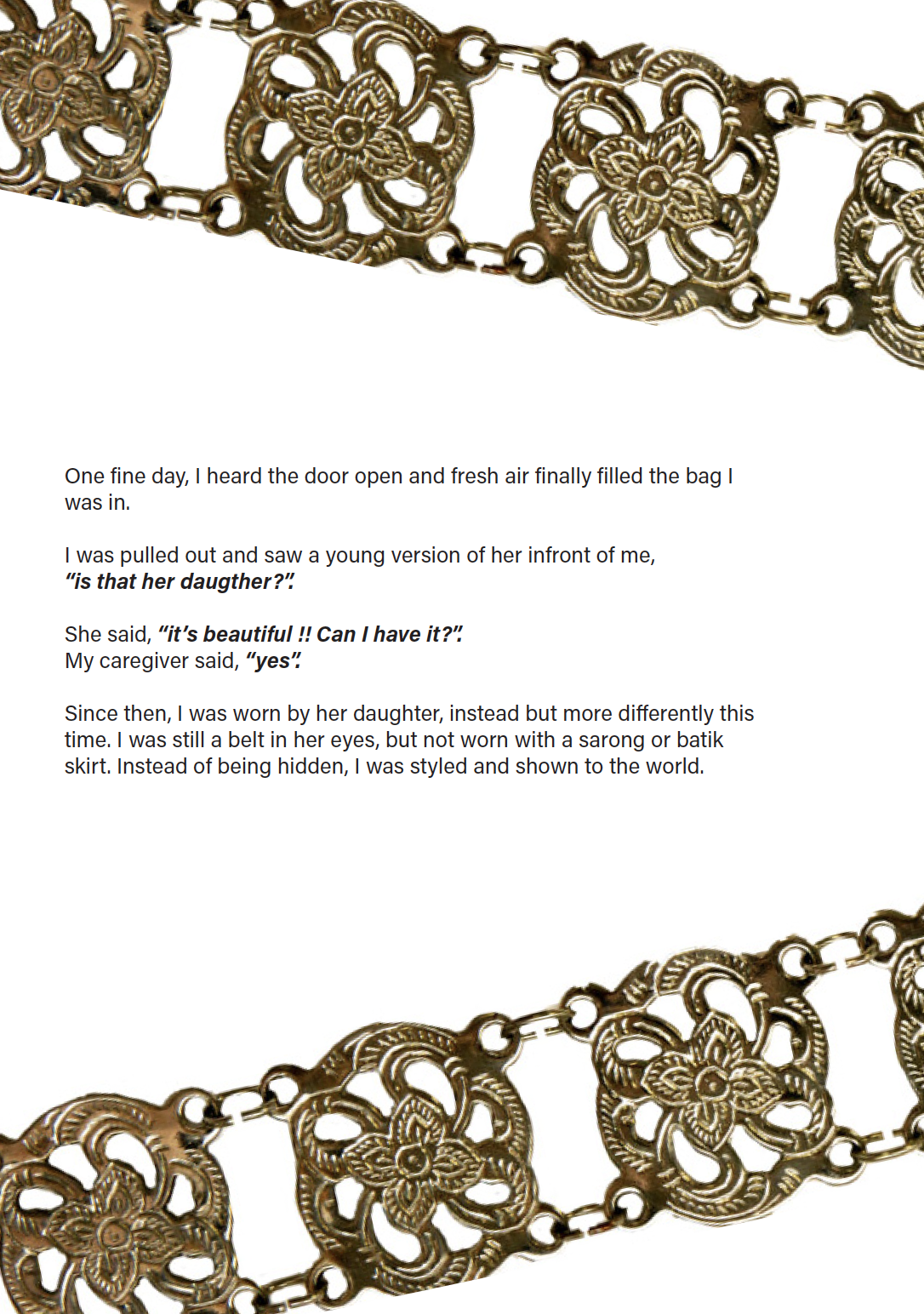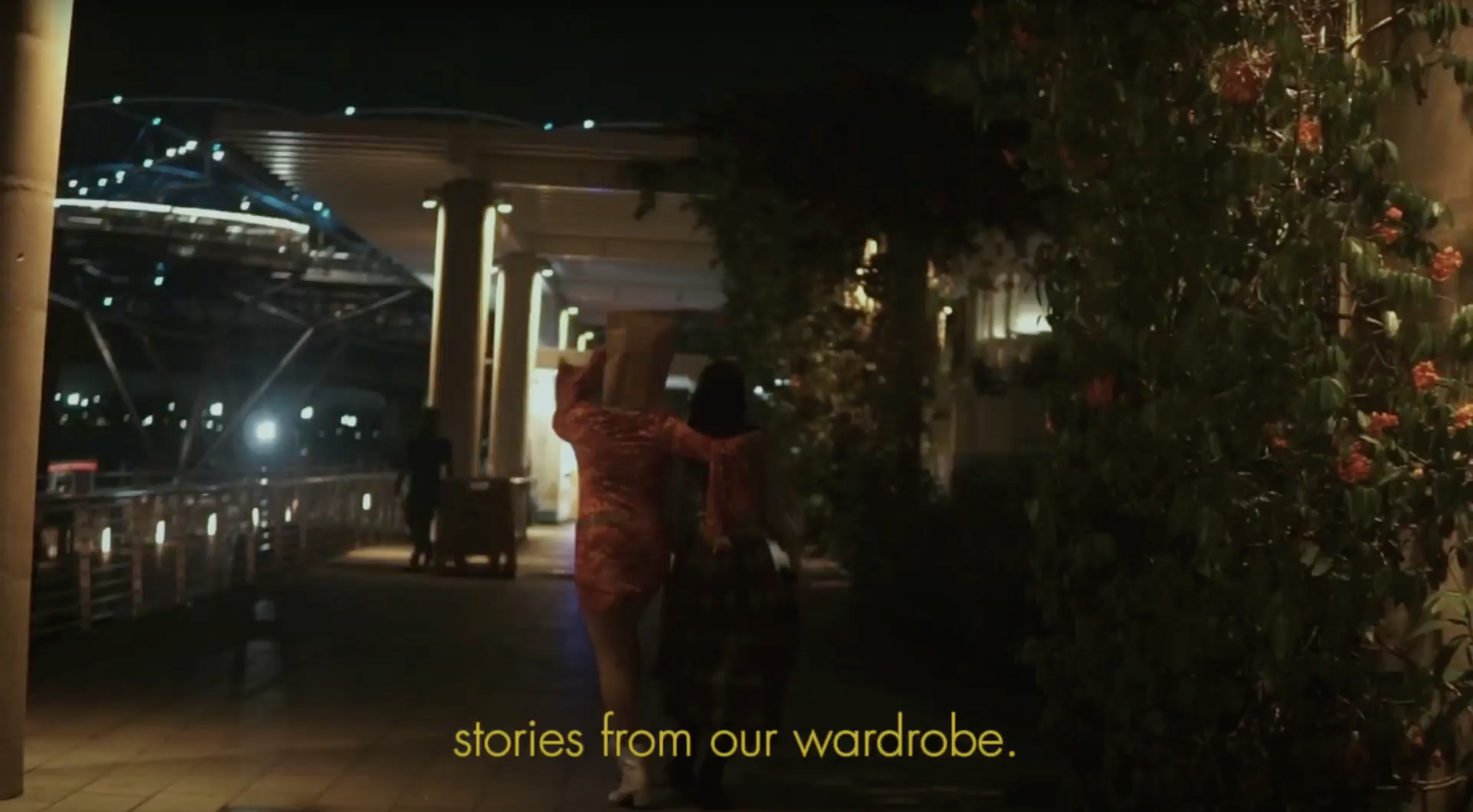
Pixie Tan is an art director and educator from Singapore. She uses her experience working in fashion, graphic, spatial design, and publishing to facilitate collaborations and propose new ways of seeing and playing.
She has worked with organizations like the Asian Civilisation Museum, Both Sides Now, and the National Youth Council to design experiences that capture and share collective wisdom. As part of her commitment to uplift and demystify the local design industry, she co-founded ground up initiative Don’t Mind If and published the inaugural report which received the SG Mark Special Mention at Singapore Good Design Award 2023.
As a fashion lecturer based in Singapore, I have observed that my students are well versed in fashion news and stories from renowned heritage fashion cities such as New York, London, Paris, and Milan. However, in developing their design and creative direction skills for social media platforms to sell and advertise fashion items, they often prioritize Western narratives over their own stories and experiences.
In the context of global fashion, there is an urgent need to diversify the voices shaping mainstream narratives, which often misrepresent, exclude, or objectify female bodies and minorities. [1] Although there has been an increase in Asian representation, it still frequently privileges the experiences of the Asian diaspora in the West. I challenge my students to reimagine their positions within fashion media. While preparing students for the future typically involves industry partnerships and speculative briefs to impart technical skills, I believe it is also crucial to foster environments that, as bell hooks advocated, embrace “experience, confessions, and testimony.” [2] My goal was to create opportunities for students to incorporate personal stories into their work and explore if a Southeast Asian perspective would emerge. [3] [4]
As part of my research for my Masters in Art Pedagogy and Practice at LASALLE College of the Arts, I created an opportunity for students to create an eight-page zine about an item from their wardrobe. For 14 weeks, from August to November 2023, students participated in three-hour sessions featuring class discussions, creative writing methods, and InDesign tutorials to articulate their stories in a printed format. At the semester's end, their zines formed a collective publication. In January 2024, we hosted a one-night-only pop-up exhibition of their zines in a thrift store of a now-defunct shopping center, titled “Stories from Our Wardrobe.” Through this project, I aimed to reclaim multiplicity in mainstream narratives by encouraging students to share their stories and design from a place of love, affirming the significance of everyday life and ordinary experiences.
The brief was simple, but bringing these stories to life through the zine-making project has been transformative for me and my students: Adawia bte Azman, Cindy Du, Elmira Binte Mohammad Hizam, Fatimah Binte Abdul Razak, Nur Insyirah Binte Mohamad Aedey, Nabilah, Katherine Lim, He Meng Xue, Rahmat bin Adnan, Vu Thi Ha Phuong, and Su Yuqian.
This piece of writing reflects on the experience of working with my students to tell their stories and the lessons I have learned from this journey.
In the context of global fashion, there is an urgent need to diversify the voices shaping mainstream narratives, which often misrepresent, exclude, or objectify female bodies and minorities. [1] Although there has been an increase in Asian representation, it still frequently privileges the experiences of the Asian diaspora in the West. I challenge my students to reimagine their positions within fashion media. While preparing students for the future typically involves industry partnerships and speculative briefs to impart technical skills, I believe it is also crucial to foster environments that, as bell hooks advocated, embrace “experience, confessions, and testimony.” [2] My goal was to create opportunities for students to incorporate personal stories into their work and explore if a Southeast Asian perspective would emerge. [3] [4]
As part of my research for my Masters in Art Pedagogy and Practice at LASALLE College of the Arts, I created an opportunity for students to create an eight-page zine about an item from their wardrobe. For 14 weeks, from August to November 2023, students participated in three-hour sessions featuring class discussions, creative writing methods, and InDesign tutorials to articulate their stories in a printed format. At the semester's end, their zines formed a collective publication. In January 2024, we hosted a one-night-only pop-up exhibition of their zines in a thrift store of a now-defunct shopping center, titled “Stories from Our Wardrobe.” Through this project, I aimed to reclaim multiplicity in mainstream narratives by encouraging students to share their stories and design from a place of love, affirming the significance of everyday life and ordinary experiences.
The brief was simple, but bringing these stories to life through the zine-making project has been transformative for me and my students: Adawia bte Azman, Cindy Du, Elmira Binte Mohammad Hizam, Fatimah Binte Abdul Razak, Nur Insyirah Binte Mohamad Aedey, Nabilah, Katherine Lim, He Meng Xue, Rahmat bin Adnan, Vu Thi Ha Phuong, and Su Yuqian.
This piece of writing reflects on the experience of working with my students to tell their stories and the lessons I have learned from this journey.



A uniquely Southeast Asian perspective emerges
Contrary to usual class formats where students are tasked with analyzing case studies in small groups, we spent the first three weeks as a class thinking about the role of objects in our lives and shared stories from our wardrobes. Students were encouraged to bring their objects from home and tell their stories to their classmates.


 Images from Unforgettable Day by Nurul Nabilah.
Images from Unforgettable Day by Nurul Nabilah.“Contrary to usual class formats where students are tasked with analyzing case studies in small groups, we spent the first three weeks as a class thinking about the role of objects in our lives and shared stories from our wardrobes.”
Through sharing, a recurring theme of familial love in the Southeast Asian context emerged. In Unforgettable Day, Nabilah put together a story of reconciliation between mother and daughter. As we flip through the pages, pieces of a puzzle slowly assemble together to reveal an illustration of herself in a patterned hijab, a style she had not tried until her mother gifted her one. As the image emerges, we also learn that the scarf represents not only a new chapter of her style but also her relationship with her mother, as she sees effort on her mother’s part to connect with her.


In Pasalubong, or a Filipino tradition of bringing gifts for family or friends after being away for a long time, Katherine, a Filipino-Singaporean-Chinese student wrote about inheriting a gold ring from her Lola, or her grandmother in Tagalog. Across eight pages, we experience the balmy heat and boredom of the Filipino countryside from a city-dwelling Gen-Z. Without a shared language, there is little in common with her mosquito swatting, gold-loving Lola until Lola one day removes and slips a treasured gold ring onto Katherine’s finger, as a gesture to connect and express love for a granddaughter she rarely sees. In less than 200 words, both stories capture the quiet, Asian manner of communicating love through gifts or service, rarely with words.


“...the autobiographical nature of the project challenged students to consider their familial ties, struggles, and growth from a unique Southeast Asian perspective that is often excluded from mainstream fashion narratives.”
In Milik Saya, Milik Dia, or Malay for “What’s mine is yours, what’s yours is mine,” Adawia writes through the eyes of a belt of sarong kebaya, a lower garment worn by women in Southeast Asia made of a long piece of cloth wrapped and tucked around the waist, as readers follow its journey from the store to her mother’s waist, hiding under the kebaya to keep a sarong in place before eventually being forgotten in a drawer of belts. Her story captures how Gen-Z reimagines traditions when the belt is found by her one day. Now used as a statement piece in her outfits, it draws compliments from friends and family for its intricate carvings, sparking conversations about its previous use as a hidden belt.
Listening to these stories revealed alternative metrics for valuing fashion items. The common expectation is that young students between the ages of 18 and 23 would be seeking the latest trends. However, the items they chose to feature were in fact not new. Many of these stories were their coming-of-age journeys, and the items they selected were markers of their independence and growth. Meng Xue wrote about a jacket she bought with her first paycheck from working at a bakery. Speaking about her experience, she often used the phrase “first step in society,” a term translated from Mandarin 踏入社会 (tá rú shé huí) which refers to the transition into adulthood as a working adult. She illustrated her stories to capture how irreplaceable her work experience has been in teaching her to weather different challenges. This is similar to how her jacket would shelter her from the rain and cold. In the same vein, in The Unbeatable Airwair 2976, Rahmat took readers on his mental health journey through his Dr Marten boots. He drew parallels between the times he kept his boots hidden and forgotten from the world to when he felt disconnected from life. The boots saw the light of day when he was in a better place and felt ready to take on the world again.
Although the brief did not specify a need to dig into their cultural roots, the autobiographical nature of the project challenged students to consider their familial ties, struggles, and growth from a unique Southeast Asian perspective that is often excluded from mainstream fashion narratives. I wonder how many more of such stories could emerge if we consciously create space for it.
In this project, I found many reasons to encourage telling these stories in offline formats. By creating them offline, we allow the stories to emerge first without the pressure of seeking likes and approval from the public eye. In my experience, the safety of the classroom space allowed students to take turns being vulnerable, revealing new sides of themselves through their stories. Through the process of creating a physical zine, they had to carefully consider the images and text that were required to tell their stories engagingly, which also gave them control over how much they would like to reveal themselves. Some students chose to illustrate their stories, imagining the worlds through the eyes of their objects without revealing themselves, while others included their photos to show the relationship between themselves and their items.
To distribute the zines beyond the classroom, I organized a one-night only zine exhibition at Second Story @ Peace Center with 11 student volunteers. Having a physical event was significant to the students who had never exhibited and sold their works before. While digital formats are easy to circulate, it is difficult to track viewer engagement beyond likes and saves. Current metrics for engagement are detailed but the data presented can often feel too intangible and fleeting. Through the exhibition, students witnessed the impact of their stories on exhibition visitors through the purchase and conversations, an experience that is difficult to replicate in digital realms. Receiving affirmations for their zines outside of the classroom assured students that their stories were interesting and of value to others.
Listening to these stories revealed alternative metrics for valuing fashion items. The common expectation is that young students between the ages of 18 and 23 would be seeking the latest trends. However, the items they chose to feature were in fact not new. Many of these stories were their coming-of-age journeys, and the items they selected were markers of their independence and growth. Meng Xue wrote about a jacket she bought with her first paycheck from working at a bakery. Speaking about her experience, she often used the phrase “first step in society,” a term translated from Mandarin 踏入社会 (tá rú shé huí) which refers to the transition into adulthood as a working adult. She illustrated her stories to capture how irreplaceable her work experience has been in teaching her to weather different challenges. This is similar to how her jacket would shelter her from the rain and cold. In the same vein, in The Unbeatable Airwair 2976, Rahmat took readers on his mental health journey through his Dr Marten boots. He drew parallels between the times he kept his boots hidden and forgotten from the world to when he felt disconnected from life. The boots saw the light of day when he was in a better place and felt ready to take on the world again.
Although the brief did not specify a need to dig into their cultural roots, the autobiographical nature of the project challenged students to consider their familial ties, struggles, and growth from a unique Southeast Asian perspective that is often excluded from mainstream fashion narratives. I wonder how many more of such stories could emerge if we consciously create space for it.
Safety in offline spaces
In this project, I found many reasons to encourage telling these stories in offline formats. By creating them offline, we allow the stories to emerge first without the pressure of seeking likes and approval from the public eye. In my experience, the safety of the classroom space allowed students to take turns being vulnerable, revealing new sides of themselves through their stories. Through the process of creating a physical zine, they had to carefully consider the images and text that were required to tell their stories engagingly, which also gave them control over how much they would like to reveal themselves. Some students chose to illustrate their stories, imagining the worlds through the eyes of their objects without revealing themselves, while others included their photos to show the relationship between themselves and their items.
To distribute the zines beyond the classroom, I organized a one-night only zine exhibition at Second Story @ Peace Center with 11 student volunteers. Having a physical event was significant to the students who had never exhibited and sold their works before. While digital formats are easy to circulate, it is difficult to track viewer engagement beyond likes and saves. Current metrics for engagement are detailed but the data presented can often feel too intangible and fleeting. Through the exhibition, students witnessed the impact of their stories on exhibition visitors through the purchase and conversations, an experience that is difficult to replicate in digital realms. Receiving affirmations for their zines outside of the classroom assured students that their stories were interesting and of value to others.

 Students preparing for the exhibition. Image by Rahmat bin Adnan
Students preparing for the exhibition. Image by Rahmat bin Adnan Screencap from Stories from Our Wardrobe trailer by Nurul Nabilah, Adawia Bte Azman and Katherine Lim. To watch: https://youtu.be/m5Xr2_uY3x8
Screencap from Stories from Our Wardrobe trailer by Nurul Nabilah, Adawia Bte Azman and Katherine Lim. To watch: https://youtu.be/m5Xr2_uY3x8
Students were required to design, market, and organize an event with the pressure of real deadlines and consequences. They were challenged to market the event, without which there would be no attendees. Reflecting on their own experiences from the classes, they created video content that captured the vulnerability of sharing their stories to be used as Instagram reels. As the date drew nearer, they took over the campus digital screens with their posters and also put up physical print outs at Peace Centre. They started to invite friends and family to the event, unsure if anyone would come.
![]()
![]() Visitors at Stories from Our Wardrobe and students selling their zines. Image by Rahamt bin Adnan.
Visitors at Stories from Our Wardrobe and students selling their zines. Image by Rahamt bin Adnan.
Thankfully, many did. Friends new and old visited the show to read their stories. The students decided amongst themselves to wear their featured items on the day of the exhibition so that visitors could identify them with their zines. The students hosted their guests, interacted with them, and took turns taking care of the videos, snack table, and the main exhibit. Priced at a small fee of SGD6 for one zine and SGD25 for five zines, many visitors bought the zines. They were surprised that others appreciated their personal stories. Despite the modest sum that each student received from the sale, one participant reflected that it was the first time they earned money from a project, signaling a transition from a student to a professional.
Many friends and visitors of the exhibition shared that the students’ excitement was palpable—the air buzzing with their enthusiasm to share their stories. As an educator, witnessing the students become spokespeople for themselves and their friends affirmed the transformative nature of telling and listening to personal stories in the classroom. I was also impressed by the growth of the students as they organized the exhibition, attaining soft skills to communicate, collaborate, and organize as a team. But most importantly, I am proud that these stories are now circulating beyond the classroom, expanding the pool of voices that represents Southeast Asia.
Notes: Stories from our Wardrobe
[1] Hall, Suzanna. “Fashion torn up: Exploring the potential of zines and Alternative Fashion Press Publications in academic library collections.” Library Trends, 70 (2021), 51–71. https://doi.org/10.1353/lib.2021.0013
[2] hooks, bell. Teaching to transgress. (Routledge, 1994)
[3] Greene, Maxine “The Need for Stories: Cultural Diversity in Classroom and Community.” National Council of Teachers of English, Urbana, (1994) 16-17
[4] Ahmed, Tanveer “All about love: How would bell hooks teach fashion design?” DRS2018: Catalyst. (2018) https://doi.org/10.21606/drs.2018.665

 Visitors at Stories from Our Wardrobe and students selling their zines. Image by Rahamt bin Adnan.
Visitors at Stories from Our Wardrobe and students selling their zines. Image by Rahamt bin Adnan.Thankfully, many did. Friends new and old visited the show to read their stories. The students decided amongst themselves to wear their featured items on the day of the exhibition so that visitors could identify them with their zines. The students hosted their guests, interacted with them, and took turns taking care of the videos, snack table, and the main exhibit. Priced at a small fee of SGD6 for one zine and SGD25 for five zines, many visitors bought the zines. They were surprised that others appreciated their personal stories. Despite the modest sum that each student received from the sale, one participant reflected that it was the first time they earned money from a project, signaling a transition from a student to a professional.
Many friends and visitors of the exhibition shared that the students’ excitement was palpable—the air buzzing with their enthusiasm to share their stories. As an educator, witnessing the students become spokespeople for themselves and their friends affirmed the transformative nature of telling and listening to personal stories in the classroom. I was also impressed by the growth of the students as they organized the exhibition, attaining soft skills to communicate, collaborate, and organize as a team. But most importantly, I am proud that these stories are now circulating beyond the classroom, expanding the pool of voices that represents Southeast Asia.
Notes: Stories from our Wardrobe
[1] Hall, Suzanna. “Fashion torn up: Exploring the potential of zines and Alternative Fashion Press Publications in academic library collections.” Library Trends, 70 (2021), 51–71. https://doi.org/10.1353/lib.2021.0013
[2] hooks, bell. Teaching to transgress. (Routledge, 1994)
[3] Greene, Maxine “The Need for Stories: Cultural Diversity in Classroom and Community.” National Council of Teachers of English, Urbana, (1994) 16-17
[4] Ahmed, Tanveer “All about love: How would bell hooks teach fashion design?” DRS2018: Catalyst. (2018) https://doi.org/10.21606/drs.2018.665
Issue 15 ︎︎︎
Fashion & Southeast Asia
Issue 14 ︎︎︎
Barbie
Issue 13 ︎︎︎ Fashion & Politics
Issue 13 ︎︎︎ Fashion & Politics

